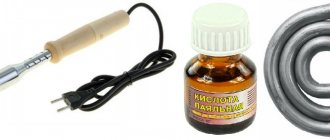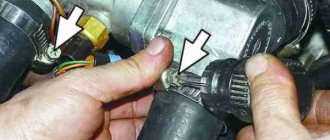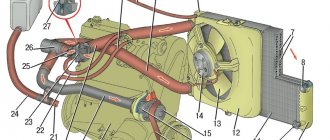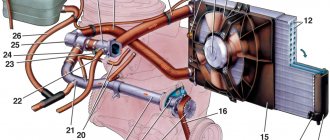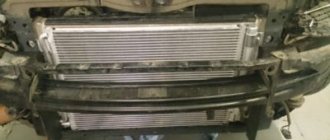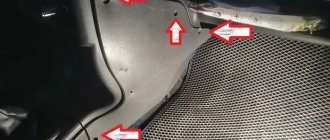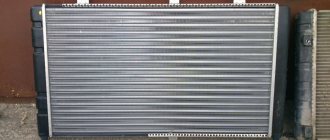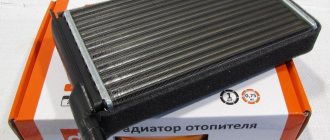Cooling radiator for VAZ cars
VAZ 2114 is considered one of the most striking examples of success of the domestic automobile industry. This model is a modified version of the VAZ 2109 and differs from it in the design of the front part of the body, updated headlights and hood, radiator grille design, as well as plastic moldings and spoilers. However, as it became known, the car is susceptible to radiator failures, which can lead to overheating, and as a result, to engine failure.
DIAGRAM AND DEVICE OF THE COOLING SYSTEM
The cooling system of the VAZ 2114 is liquid, with forced circulation. Antifreeze or antifreeze is poured into the system as a coolant. In the most extreme case, you can fill it with water, but you can’t drive it for a long time - in winter you can defrost the engine, and during the rest of the season, when the engine is used for a long time on water, the cooling jacket in the block and cylinder head is corroded, and rust accumulates in the radiator.
The VAZ 2114 engine cooling system (SOD) consists of the following elements:
- Radiator. It is the main cooling part in the system and performs the function of transferring heat to the liquid into the surrounding airspace;
- Water pump (pump). The pump creates forced movement of antifreeze in the system, thereby cooling the entire SOD, including the internal combustion engine (ICE). The pump rotates from the timing belt;
- Branch pipes (hoses). Antifreeze circulates through them;
- Thermostat. It regulates the passage of coolant through all pipes or only in a small circle and maintains the required operating temperature of the internal combustion engine;
- Electric fan. The fan is located on the plane of the radiator and, due to the air flow created, cools its surface when turned on. The electric motor turns on only when the temperature set by the sensor is reached (103°C);
- Expansion tank. Liquid is poured into the tank, and when the fan is activated, antifreeze flows into it through the return hose, thereby releasing excess pressure into the SOD;
- Expansion tank plugs. There are valves in the plug that relieve excess air pressure created in the system when antifreeze circulates.
The VAZ 2114 cooling diagram is shown in the figure below:
Cooling diagram for VAZ-2114
The design of the engine cooling system on the VAZ model 2114 is simple and practically no different from the design of any other fuel-injected internal combustion engine of a passenger car. After starting the engine, the water pump is driven by the rotating crankshaft through the timing belt. The pump creates coolant circulation in the system, and the antifreeze passes through a small circle (pump, upper pipe, cylinder block). When the internal combustion engine is heated to operating temperature, the thermostat valve opens and the coolant flows through the lower pipe into the internal combustion engine in a large circle.
RADIATOR
The VAZ radiator is aluminum, consists of a double-row core and two plastic tanks on the sides. Coolant is poured into it through the expansion tank; there is a drain plug at the bottom.
PIPE
The set of cooling system pipes includes:
- Upper and lower pipes (main);
- Metal tube of water pump;
- Filler hose from the expansion tank to the radiator;
- Return hose from tank to radiator;
- Two hoses for heating the throttle valve.
Check the integrity of the pipes (very often they sell defective ones in car dealerships)
Required spare parts
First of all, you need to select a new radiator. It is better to purchase an analogue of what is on your car. You can also make a choice by article number: 2108-1301012, 21082-1301012, RO2108-01, LRc 01082.
The average price of a new unit is 1,750 rubles. Copper models will cost more.
Attention ! It is better not to purchase painted radiators, since there is a risk of an unpleasant odor appearing in the interior, and the heat transfer of these models is lower.
COOLING SYSTEM PROBLEMS
As a rule, due to malfunctions in the cooling system, the engine overheats, and this leads to engine failure. Any of the elements may be faulty.
Radiator:
- It may leak. Possible leakage through aluminum tubes and plastic tanks. Often the plastic outlet for the return hose of the expansion tank breaks off.
- It may clog, and for this reason the engine will heat up.
Pipes. Because of them, antifreeze leaks due to the fact that the pipe:
- Ragged.
- Old and lost elasticity.
Thermostat. Depending on how incorrectly the valve in the thermostat operates, the internal combustion engine can:
- Overheat (in this case, the antifreeze “throws out” through the expansion tank).
- Do not reach operating temperature. As a result, the car drives poorly, and in cold weather it is cold inside the car.
Water pump (three main problems):
- Noise and play in bearings. It is not worth driving with such a defect for a long time; the pump may jam or fall apart.
- Liquid is leaking through the inspection hole. It also signals the imminent “death” of the part.
- Broken impeller. With such a defect, the engine overheats very quickly.
Cooling Fan:
- A faulty fan also leads to overheating of the internal combustion engine.
The clamps may be faulty or poorly tightened. It happens that thin hoses become clogged with debris (“return”, throttle valve heating).
Why the OS does not work
The cooling system most often stops working due to improper operation of the thermostat. You can't do anything other than replace it.
If you don’t know which cooling radiator is best to choose for the VAZ 2114, look at the existing one. Buy an analogue from the manufacturer, or purchase a device with the closest characteristics.
The fourteenth model is equipped with an aluminum radiator with two additional tanks. The radiator design includes:
- Radiator;
- Upper tank with pipes;
- Bottom tank with pipes.
REPAIR OR REPLACEMENT OF RADIATOR
Let us consider in detail the features of the work.
RINSE
Replacing the cooling radiator is required if the internal combustion engine heats up due to its clogging. But before changing it, you can try flushing the cooling system of the VAZ 2114 engine. Often flushing helps, and the engine stops heating up. We perform washing as follows:
- We park the car on a level surface;
- Unscrew the expansion tank cap;
- Drain the coolant from the radiator by unscrewing the bottom plug;
- We unscrew the water plug from the cylinder block (it is located between the internal combustion engine and the fan in the starter area) and drain the antifreeze from the block;
- We wrap the plugs and fill the system with plain clean water;
- Let the engine run and drain the water. If the water that comes out is dirty, repeat the flushing. We repeat the procedure several times until the draining water becomes clear;
- After flushing, fill in new coolant. It should be noted that the volume of the VAZ 2114 cooling system is 7.8 liters, and if all the antifreeze is not included in the system, most likely an air lock has formed in it. It is necessary to fill the container as much as possible to avoid overheating of the internal combustion engine.
It is often recommended to do the flushing on a cold engine to avoid being scalded by hot antifreeze. On the one hand, it seems to be true, but in cold weather all the dirt will settle on the walls of the SOD, and the washing efficiency will not be so great. And don’t wait every time for the water to cool down. You just need to drain the coolant carefully and work in thick, waterproof clothing and gloves. You also need to remember that the shelf life of antifreeze and antifreeze ranges from 2 to 5 years.
REPLACEMENT
Replacing the cooling radiator on a VAZ is very simple:
- Remove the expansion tank plug;
- Drain the antifreeze from the radiator and cylinder block. It is necessary to prepare a container for liquid in advance;
- We dismantle the air filter housing, it will interfere with removing the radiator;
- Disconnect the electric fan plug, unscrew the two bolts securing it and dismantle the unit;
- We loosen the clamps where it is more convenient and pull off the pipes;
- In the upper part of the radiator, remove the two bolts securing it to the body frame, tilt its body towards the engine and remove the part. Radiator removal is complete;
- We reassemble in the reverse order, then fill in antifreeze and start the engine.
REPAIR
If you wish, you can make minor repairs to the engine cooling yourself, but more often they repair it as a necessary measure:
- If you need to get to some destination;
- In the case when they did not expect a replacement and there is no money yet.
Plastic tanks can be sealed with epoxy resin or soldered; against leakage through the honeycombs, a special chemical composition is used, which is added to the antifreeze and clogs the leaking areas. But it is possible that such chemistry will complicate the passage of coolant throughout the system.
It’s easier not to be tricky with the radiator, but to replace it, especially since it is inexpensive, somewhere from 1,200 rubles.
Therefore, do-it-yourself repairs often become economically unjustified, and a lot of time is spent on useless “treatment.” True, there are more expensive copper radiators, but they are easier to repair - copper can be soldered.
Repairing the thermostat is hardly advisable; it is better to replace such a part immediately. Moreover, it costs about 350-500 rubles.
REPLACEMENT OF PIPE
Replacing the pipes of the VAZ 2114 cooling system is very simple - drain the coolant, loosen the clamp and replace it. In stores, pipes are often sold as a set, and it is also recommended to change them as a set.
Replacing pipes is simple (you can apply sealant to the joints)
Choosing a heater radiator for VAZ 2114, 2113, 2115
Which radiator to choose for the stove on a VAZ 2114? This question is gaining relevance in connection with the approaching winter. It's no secret that not all domestically produced cars have a good heater. Let's try to figure out which radiator to choose:
Copper radiator.
Immediately after purchase, the copper radiator has a heat output of 389.6 W/(m. deg).
The properties of copper are such that such a radiator takes a long time to heat up and takes a long time to cool down. The number of fins in a copper radiator is smaller than in an aluminum one, and the cross-section of the channels is smaller. Therefore, they clog faster and the stove blows cool air at idle. Most often, this is what VAZ owners complain about. The advantages of a copper heater radiator include its maintainability. This is where the advantages end. And the disadvantages begin: recently, manufacturers have been saving on raw materials and using impure copper. Some paint radiators to give them a marketable appearance, but this reduces the heat transfer of such a radiator. Lately it has been very difficult to find a high-quality copper radiator.

